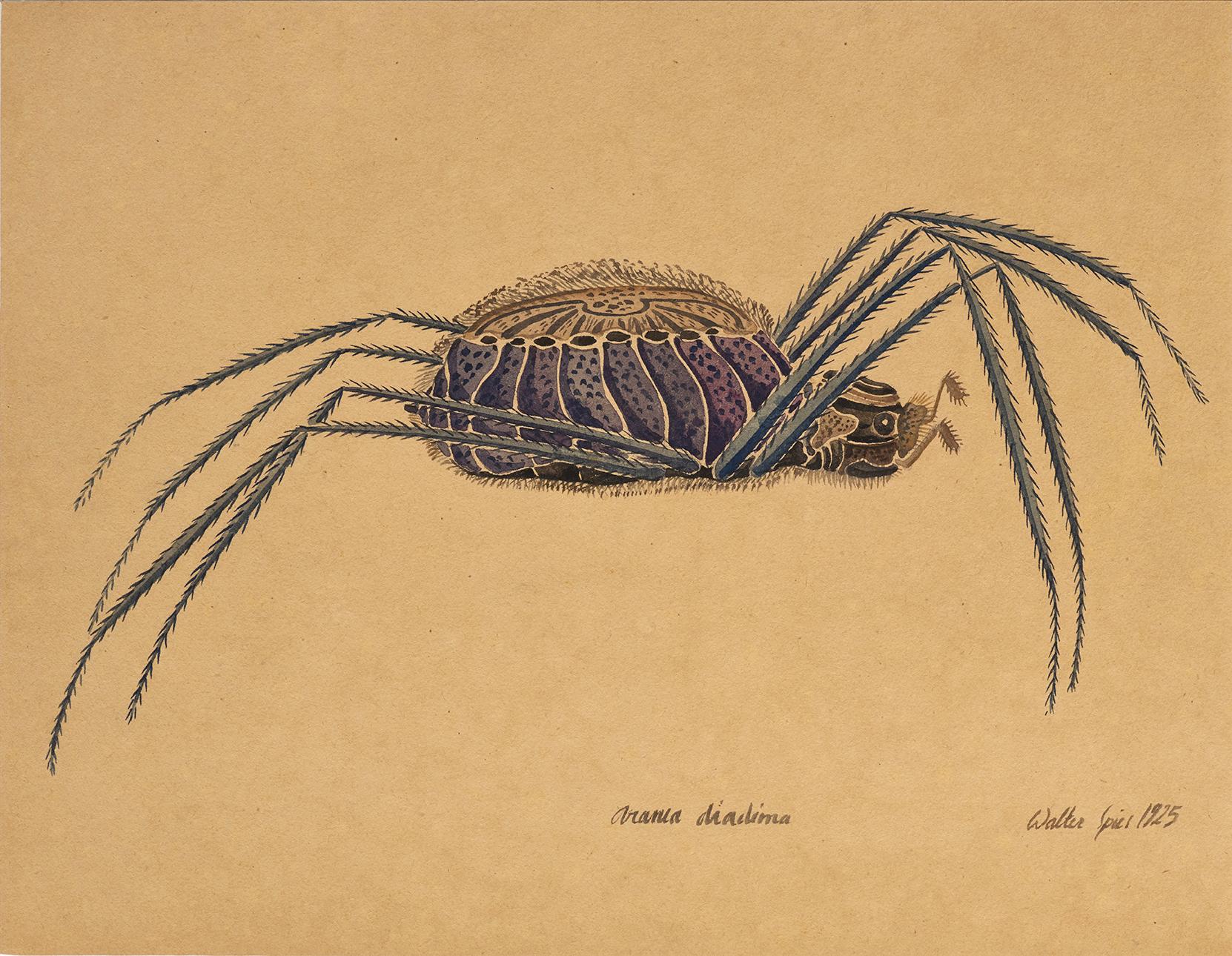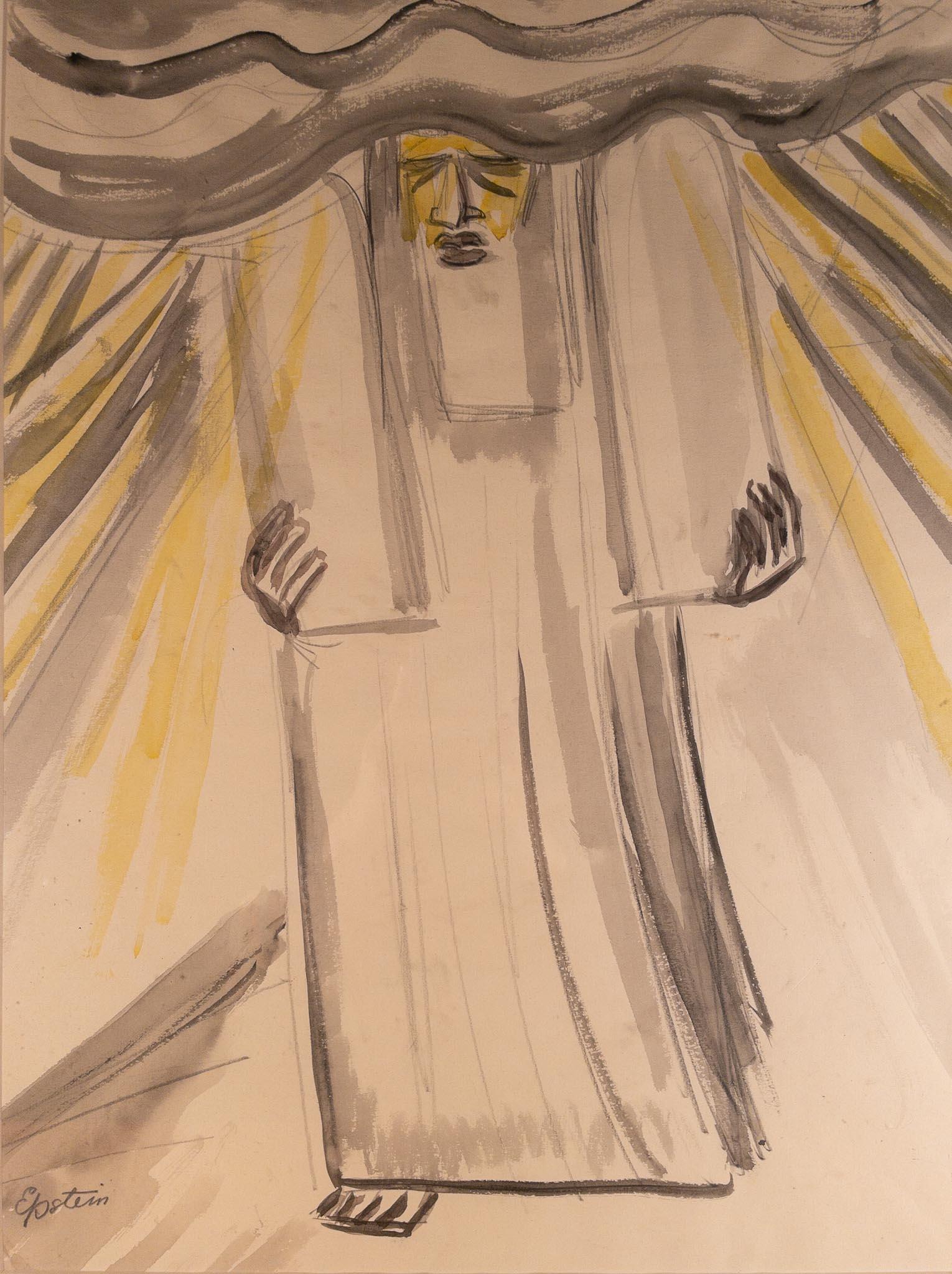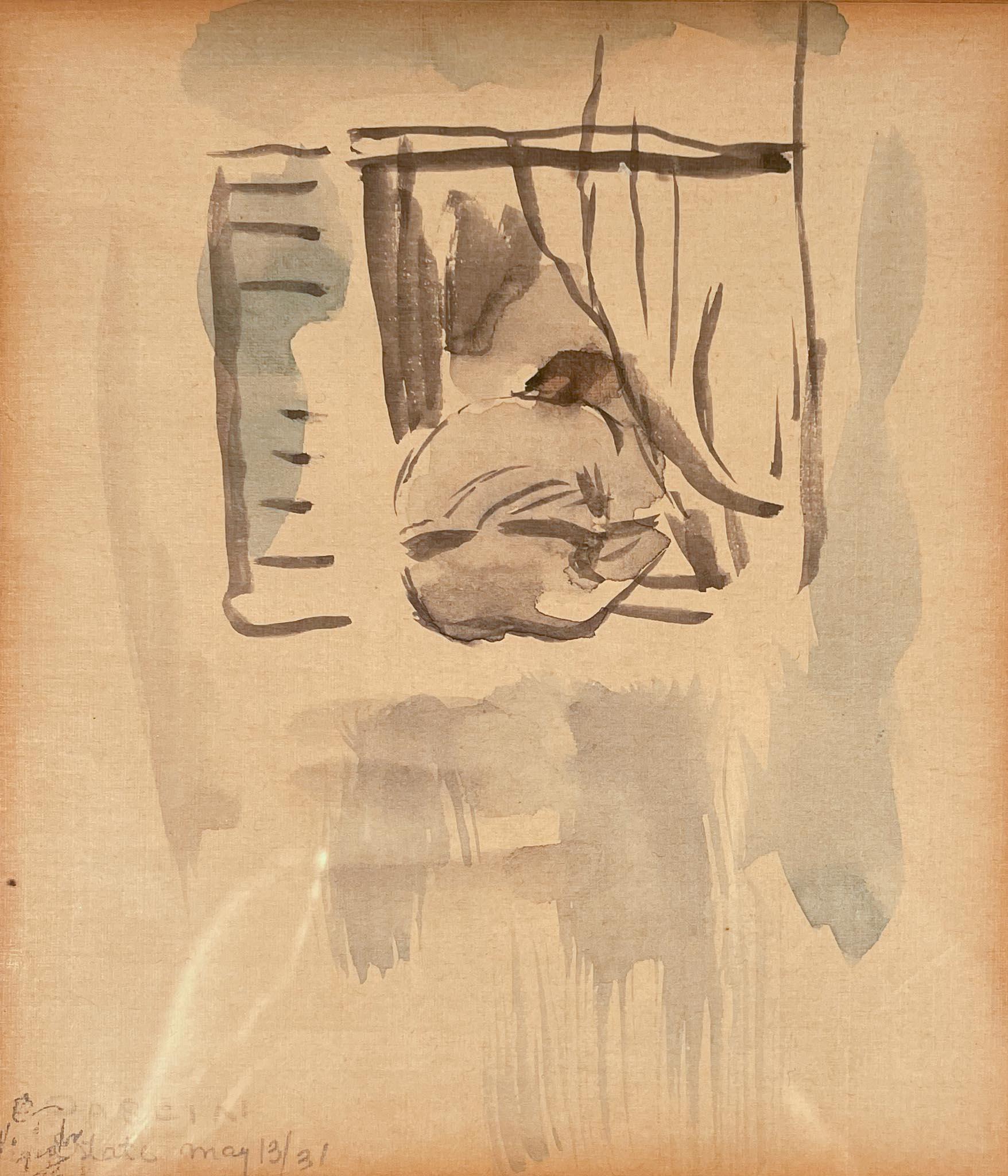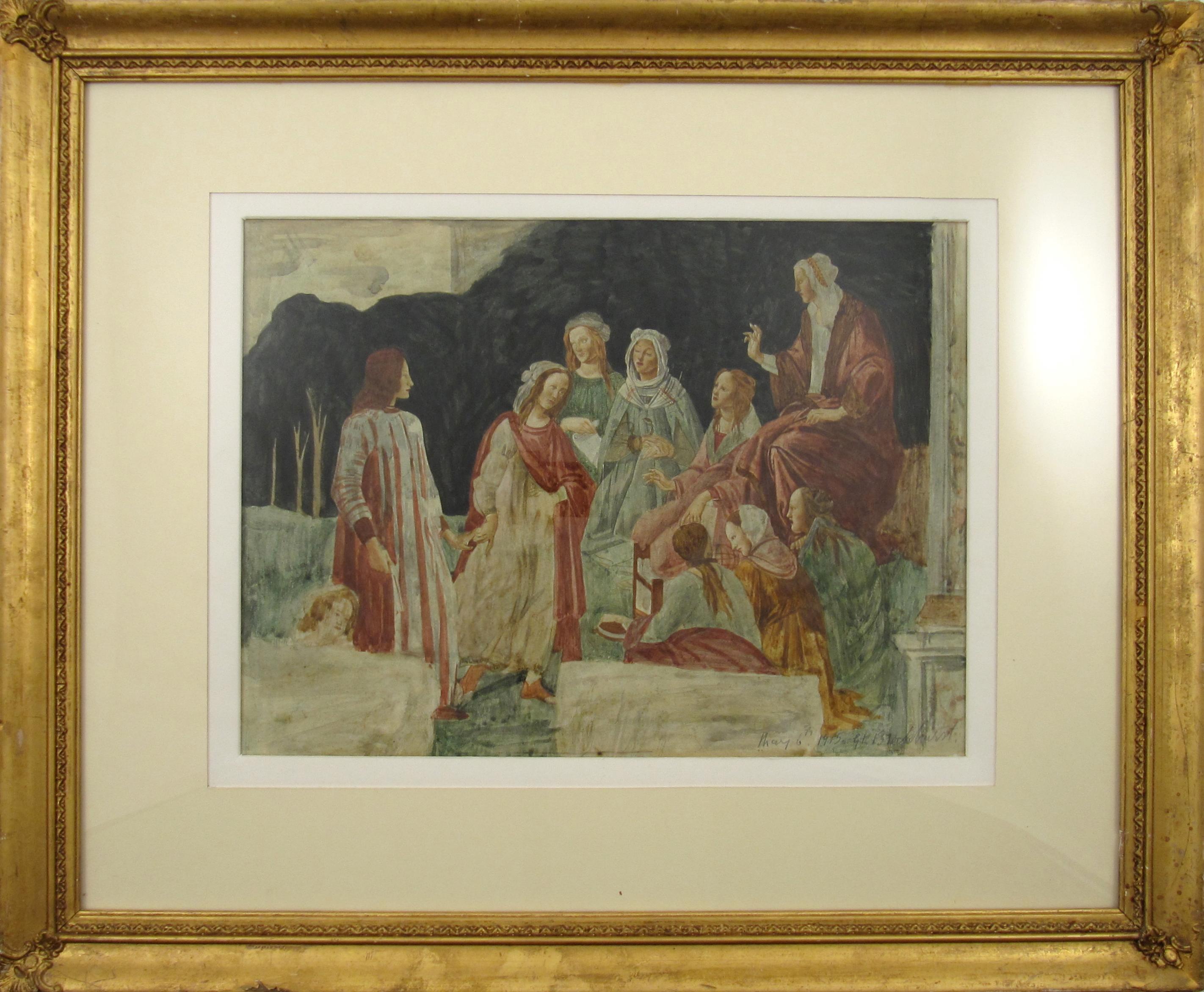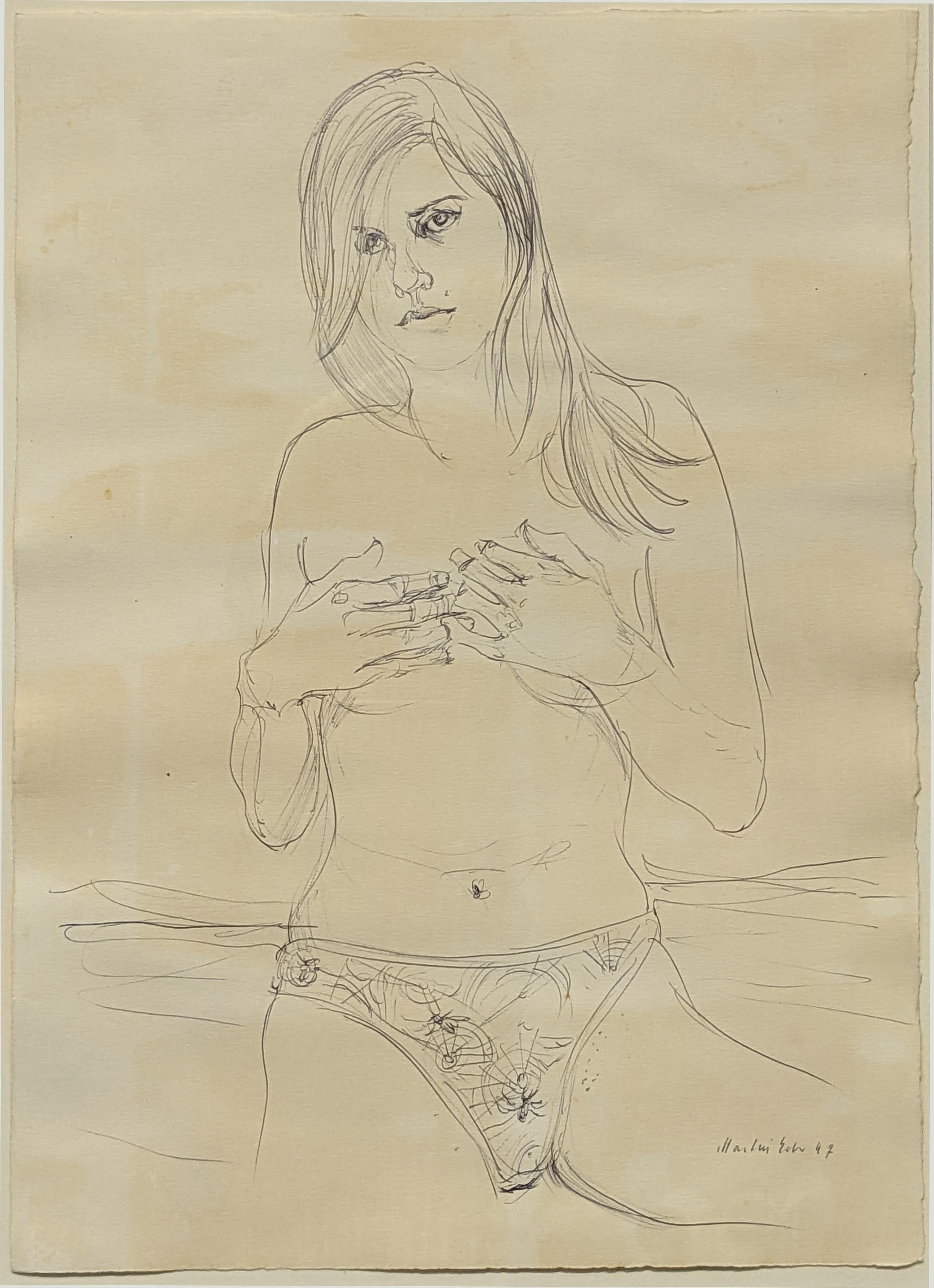Items Similar to Women with Parrot on Arm
Want more images or videos?
Request additional images or videos from the seller
1 of 8
Katherine LibrowiczWomen with Parrot on Arm
About the Item
Harriet Gans, photographer who showed her work in New York galleries and museums
A native of Manhattan, Ms. Gans was a graduate of the University of California, Berkeley, and held a master's in psychology from Columbia University. She was a professor of photography at Pace University.
She had solo exhibitions at the Julie Saul and Pindar Galleries in New York. She contributed studies of flowers to the In Bloom Traveling Exhibit at the Museum of Modern Art in 1990.
an exhibition, "In Celebration of Harriet Gans: Artists of the MacDowell Colony," consisting of 56 works by 16 painters and print makers
In photography, she explored nature, mythology and spirituality, producing work that was shown in solo and group exhibitions; the Museum of Modern Art included her flower studies in its 1990 traveling show, "In Bloom." Ms. Gans also contributed to The New York Times and other publications, and taught in the art department of Pace University
The photographer's later work was divided into three phases, each of which is represented in the Krasdale show. These include luminous arrangements of seed pods photographed against a black background, vivid abstractions of flowers in various stages of bloom and decay and the haunting "Longing" series, in which eternal mysteries are poignantly captured.
The curators have underscored the themes in Ms. Gans's life and work with paintings and graphics by artists like Benny Andrews, Heidi Fasnacht, Clare Romano, John Ross and April Vollmer.
Of all the MacDowell fellows represented in the exhibition, only the Manhattan painter Susan Hambleton was at the colony when Ms. Gans was there. Her work seems most spiritually akin to the photographer's works in its depiction of glowing waters rushing out of darkness and cascading back into darkness, a metaphor for life's evanescence.
Ms. Gans was also a fellow of the Yaddo Colony in Saratoga Springs
- Creator:Katherine Librowicz (1912 - 1991, Polish)
- Dimensions:Height: 22.82 in (57.97 cm)Width: 17.75 in (45.09 cm)
- Medium:
- Period:
- Condition:Minor wear and tear with age.
- Gallery Location:Surfside, FL
- Reference Number:1stDibs: LU38211060012
About the Seller
4.9
Platinum Seller
These expertly vetted sellers are 1stDibs' most experienced sellers and are rated highest by our customers.
Established in 1995
1stDibs seller since 2014
1,548 sales on 1stDibs
Typical response time: 1 hour
- ShippingRetrieving quote...Ships From: Surfside, FL
- Return PolicyA return for this item may be initiated within 3 days of delivery.
More From This SellerView All
- Rare Large Collage New York Cityscape Skyline Assemblage PaintingBy Gottfried SalzmannLocated in Surfside, FLGottfried Salzmann worked on a series of photo collages inspired by the city streets and the urban. In this collage the artist cuts and crops pieces of newspaper, and attaches them t...Category
20th Century Modern Figurative Drawings and Watercolors
MaterialsPaint, Paper, Mixed Media, Watercolor
- Original Graphic Hungarian Illustration Art Emma Heinzelmann Children's Book ArtLocated in Surfside, FLOriginal vintage gouache painting on poster board by Emma Heinzelmann (Hungarian, born 1930). Hungarian Peasant art, children fairytale themes, in psychedelic pop colors of the era. This framed painting depicts figures, a rooster and angels in flying above. Artist signature on farm gate. Housed in chrome mid century frame. Framed: 19.5 X 25.5 image is 15 X 21. Emma Heinzelmann ( Nyírbátor , March 14 , 1930 - ) Munkácsy Prize-winning Hungarian graphic designer and illustrator. Heinzelmann is a Hungarian children's book illustrator and graphic poster artist, who started her career during the 1950’s. She has a very unique drawing style that resembles children’s book illustrations. Working in psychedelic pop colors of the era. She Initially she studied to be a costume designer but she soon turned to graphic design. She graduated in 1950 from the clothing design department at the Junior High School in Török Pál Street which operated under the name Szépmíves Lyceum from 1946 to 1950. His master was György Farkas, a ceramicist, painter and sculptor. She creates her compositions using mainly watercolor and gouache paint. She often worked on illustrations for children’s books, since her style fits their themes. Her posters show the same playful Hungarian Folk Art style. She has produced artwork in almost all areas of applied graphics. posters, commemorative cards, designed album covers, postcards, advertising graphics, slide films, animation and cartoons. Her drawings were published in Dörmögő Dömötör and Kisdobos among others as well as in children's magazines. An entire generation of children grew up with her book illustrations, reading the fairy tales of Wilhelm Hauff or Hans Christian Andersen. Her story books and drawings are known well beyond our borders. She illustrated nearly 80 storybooks. She is a contemporary of Maurice Sendak and William Steig. Her work is of the same genre as the iconic Polish Cyrk poster artists. In her original fine art graphics grotesque and bitter elements often prevail, her figures are playfully ironic. Her drawings are made in a variety of ways, from pencil drawings to watercolor painting to collage techniques, from decorative spot effects to lace-like line drawings. She is no stranger to a kind of Art Nouveau influence, but it is always individual. It was never beautiful, but over the years its color scheme changed, thus confirming the lines of József Somogyi quoted earlier. She had several individual exhibitions, and for more than 10 years as a member of the Papp-Gábor group, her works could be seen in Dorottya Street. In 2009 , the book of art historian András Székely was published by Holnap Könyvkiadó under the title Emma Heinzelmann: fairy tales in the drawing. Awards and recognitions Lot Prize (International Poster Biennale, Warsaw) (1972) Ministry of Culture Award (1977, 1979) Brno Graphic Biennale (Bronze Award) (1980) Worker's Award (1984) Children's Book of the Year Award (1984) IBBY Andersen Diploma (1988) Hamburg Lifetime Achievement Award (1990) Albert Star Award (1992) Noémi Ferenczy Award (2005) Munkácsy Award (1984) Solo Exhibitions: Thought Bookstore, Budapest (1965) Cultural Center, Nyíregyháza (1974) Little Gallery, Komárom (1982) Art Gallery, Budapest. (1990) Vác (2010) Selected group exhibitions: International Children's Book Fair and Exhibition, Bologna (1971-1975) International Graphic Biennale, Brno (1966-1985) BIB (Children's book illustration biennial), Bratislava (1970-1985) XXXVI. Venice Biennale, Venice (1972) ARC. International Poster Biennale, Warsaw (1972) International Poster Triennale (B) (1972-1974) Weekdays, graphic exhibition, (1975) Calligraphy and typography, Institute of Cultural Relations, Budapest (1977) "Falrahányt pea", graphic exhibition, Institute of Cultural Relations, Budapest.(1978) International Poster Triennale (B) (1978) National Poster Exhibitions, Art Gallery, Budapest (1978)(1980) International Poster Exhibition (IR) (1979) Slide films: Fairy tales with Emma Heinzelmann's drawings: Under the Shore (1981) Goose Party (1981) Take a Little Trumpet (1982) The Bremen Town...Category
Mid-20th Century Folk Art Figurative Paintings
MaterialsGouache
- 1940's Americana WPA Modernist Watercolor Painting Catskill Mountains BungalowBy Samuel GrunvaldLocated in Surfside, FLBungalow (fauvist painting of New York scene) 1940's. image is 10X 11.5 inches. Hand signed lower right Country Scene Samuel Grunvald was a Hungarian born American WPA artist known for abstract, landscape and seascape paintings. Arrived in the USA from Hungary in 1921 and settled in New York City where he studied at the Art Students League. Grunvald worked for the Federal Art Project, taught at Colony House in NYC. Member: Art Guild, Watercolor Society, New York Watercolor Club. exhibited at Montross Gallery, NYC, World House Galleries, NYC, Leonard Hutton Gallery, NYC, Associated American Artists Gallery and the A.C.A. Gallery. Gunvald's work spanned many modern American movements from the WPA to Abstract Expressionist painting. He was a member of the American Watercolor Society and the Brooklyn Society of Artists. He exhibited with both of these organizations and at the Brooklyn Museum of Art. He was involved the the WPA being a Federal Arts Project artist. A number of prominent Jewish artists participated in this New Deal program among them Ben Shahn, Joseph Solman, William Gropper, Philip Guston Adolph Gottlieb, Mark Rothko, Milton Avery, Ben Shahn, the Soyers (Isaac, Moses, and Raphael), and many others Grunwald exhibited alongside other popular artists such as Paul Klee, Jean Arp, Max Ernst and Charles Burchfield. He also taught and lectured on art and easel painting, Federal Art Project, NYC. His work is included in the collections of the Museum of Modern Art and The Jewish Museum, New York. Americana. The Catskills became a major resort destination for Jewish New Yorkers in the mid-20th century. Borscht Belt is an informal term for the summer resorts of the Catskill Mountains in Sullivan and Ulster counties in upstate New York which were frequented by Ashkenazi Jews. At its peak of popularity, about 500 resorts operated in the region. Later changes in vacationing patterns have led most of those travelers elsewhere, although there are still bungalow communities and summer camps in the towns of Liberty, Bethel, Monticello and Fallsburg catering to Orthodox Jewish populations. Borscht Belt, The term, which derives from the name of a beet soup popular with people of Eastern European origin, can also refer to the Catskill region itself. In August, 1969, the Catskills were the site of a music and art festival in the town of Bethel, which had originally been planned for Woodstock, New York. Thirty-three of the best-known musicians of the era appeared during a sometimes rainy weekend in front of nearly half a million concertgoers. The event, featuring liberal drug use and nudity, exemplified the counterculture of the 1960s and 1970s. Select Exhibitions A.C.A. Gallery Associated American Artists Gallery, 1936-1955 American Watercolor Society, 1932-1942 New York Watercolor Club, 1935-1937 Humanist Art...Category
1940s Modern Figurative Drawings and Watercolors
MaterialsWatercolor
- Original Graphic Hungarian Illustration Art Emma Heinzelmann Children's Book ArtLocated in Surfside, FLOriginal vintage gouache painting on poster board by Emma Heinzelmann (Hungarian, born 1930). Hungarian Peasant art, children fairytale themes, in psychedelic pop colors of the era.This painting that depicts figures including a crowned pig, and a princess in a bed. Artist signature above bed. Housed in chrome mid century frame. Framed: 19.5 X 25.5 image is 14.75 X 21.25. Emma Heinzelmann ( Nyírbátor , March 14 , 1930 - ) Munkácsy Prize-winning Hungarian graphic designer and illustrator. Heinzelmann is a Hungarian children's book illustrator and graphic poster artist, who started her career during the 1950’s. She has a very unique drawing style that resembles children’s book illustrations. Working in psychedelic pop colors of the era. She Initially she studied to be a costume designer but she soon turned to graphic design. She graduated in 1950 from the clothing design department at the Junior High School in Török Pál Street which operated under the name Szépmíves Lyceum from 1946 to 1950. His master was György Farkas, a ceramicist, painter and sculptor. She creates her compositions using mainly watercolor and gouache paint. She often worked on illustrations for children’s books, since her style fits their themes. Her posters show the same playful Hungarian Folk Art style. She has produced artwork in almost all areas of applied graphics. posters, commemorative cards, designed album covers, postcards, advertising graphics, slide films, animation and cartoons. Her drawings were published in Dörmögő Dömötör and Kisdobos among others as well as in children's magazines. An entire generation of children grew up with her book illustrations, reading the fairy tales of Wilhelm Hauff or Hans Christian Andersen. Her story books and drawings are known well beyond our borders. She illustrated nearly 80 storybooks. She is a contemporary of Maurice Sendak and William Steig. Her work is of the same genre as the iconic Polish Cyrk poster artists. In her original fine art graphics grotesque and bitter elements often prevail, her figures are playfully ironic. Her drawings are made in a variety of ways, from pencil drawings to watercolor painting to collage techniques, from decorative spot effects to lace-like line drawings. She is no stranger to a kind of Art Nouveau influence, but it is always individual. It was never beautiful, but over the years its color scheme changed, thus confirming the lines of József Somogyi quoted earlier. She had several individual exhibitions, and for more than 10 years as a member of the Papp-Gábor group, her works could be seen in Dorottya Street. In 2009 , the book of art historian András Székely was published by Holnap Könyvkiadó under the title Emma Heinzelmann: fairy tales in the drawing. Awards and recognitions Lot Prize (International Poster Biennale, Warsaw) (1972) Ministry of Culture Award (1977, 1979) Brno Graphic Biennale (Bronze Award) (1980) Worker's Award (1984) Children's Book of the Year Award (1984) IBBY Andersen Diploma (1988) Hamburg Lifetime Achievement Award (1990) Albert Star Award (1992) Noémi Ferenczy Award (2005) Munkácsy Award (1984) Solo Exhibitions: Thought Bookstore, Budapest (1965) Cultural Center, Nyíregyháza (1974) Little Gallery, Komárom (1982) Art Gallery, Budapest. (1990) Vác (2010) Selected group exhibitions: International Children's Book Fair and Exhibition, Bologna (1971-1975) International Graphic Biennale, Brno (1966-1985) BIB (Children's book illustration biennial), Bratislava (1970-1985) XXXVI. Venice Biennale, Venice (1972) ARC. International Poster Biennale, Warsaw (1972) International Poster Triennale (B) (1972-1974) Weekdays, graphic exhibition, (1975) Calligraphy and typography, Institute of Cultural Relations, Budapest (1977) "Falrahányt pea", graphic exhibition, Institute of Cultural Relations, Budapest.(1978) International Poster Triennale (B) (1978) National Poster Exhibitions, Art Gallery, Budapest (1978)(1980) International Poster Exhibition (IR) (1979) Slide films: Fairy tales with Emma Heinzelmann's drawings: Under the Shore (1981) Goose Party (1981) Take a Little Trumpet (1982) The Bremen Town...Category
Mid-20th Century Folk Art Figurative Paintings
MaterialsGouache
- Americana, Lawyer in Court, Politician, Gouache Painting WPA Art William GropperBy William GropperLocated in Surfside, FLWilliam Gropper Original Gouache on Paper Hand signed lower right 33.5 x 27.5 image 26 x 20.5 The New-York born artist William Gropper was a painter and cartoonist who, with caricature style, focused on social concerns, and was actively engaged in support of the organized labor movement throughout his career. This original watercolor drawing is done in the iconic style of the artist's oeuvre. Born to Harry and Jenny Gropper in 1897, William was raised in New York City's Lower East Side. His parents were Jewish immigrants from Romania and Ukraine, and young William grew up in relative poverty, watching his family struggle to achieve that sought-after American dream. His father, a bright and college-educated man, was unable to find employment that worthy of his intellect. His mother, meanwhile, worked as a seamstress from home. Coupled with the devastating loss of an aunt to the infamous Triangle Factory fire of 1911, significant childhood factors created the foundation that led to Gropper’s exploration of the American experience. Early on, Gropper displayed an extraordinary, natural skill for art. By 1912, he was already studying under the instruction of George Bellows and Robert Henri at the Ferrer School in Greenwich Village. During his time at school, Gropper was also awarded a prestigious scholarship to study at the National Academy of Design. However, he refused to fit into convention and was swiftly expelled from the Academy. After his expulsion, Gropper returned home to help financially by assisting his mother and taking a shop position. However, he didn't abandon art academia and soon presented a portfolio to the New York School of Fine Art which earned him a scholarship for study. Gropper obtained his first significant job as a cartoonist for the New York Tribune in 1917. While working as a staff cartoonist for the Tribune, he also contributed drawings to publications like Vanity Fair, New Masses, The Nation, and Freiheit. His interest in the welfare of the American worker, class inequality, and social injustice was central in his work. After publishing the graphic novel Alley Oop in 1930, Gropper's illustration career extended well into the decade. However, he was never exempt from controversy, and his 1935 Vanity Fair cartoon; prompted anger from the Japanese government. As an involved labor organizer and Social Realist activist, Gropper continued to bring attention to his radical reputation with visits to the Soviet Union and Poland. However, his concern with European politics and U.S. social causes didn't slow down his artistic career, and by the late 1930s, he had produced significant murals for American cities like Washington D.C. His 1938 mural Construction of a Dam was commissioned for the Department of the Interior and represents the Social-Realism style that depicts experiences of the worker and everyday societal life. Measuring at a staggering 27ft by 87ft, the piece portrays muscular, robust American laborers scaling rocky hillsides, building infrastructure, and operating heavy machinery. The mural feels undeniably American with golden scenery, denim blues, and steely gray colors. Gropper fits perfectly into Social-Realism because the style exhibits an illustrative flair with strong lines and simple, bold hues. The inspiration for Construction of a Dam sprang from his 1937 travels to the poverty-stricken Dust Bowl area. The trip was sponsored by a Guggenheim Foundation Fellowship, and his drawings of the Grand Coulee and Boulder Dams...Category
Mid-20th Century Modern Figurative Paintings
MaterialsInk, Watercolor, Gouache
- Untitled, ParadeBy Hajo MalekLocated in Surfside, FLGerman outsider Naive artist born in 1922. has exhibited in Germany in 1969 worked in painting, gouache and linocuts. Expressionist Folk Art style.Category
20th Century Outsider Art Figurative Drawings and Watercolors
MaterialsWatercolor, Gouache
You May Also Like
- The Abduction of the Sabine Women , a Renaissance drawing by Biagio PupiniLocated in PARIS, FRThis vigorous drawing has long been attributed to Polidoro da Caravaggio: The Abduction of the Sabine Women is one of the scenes that Polidoro depicted between 1525 and 1527 on the façade of the Milesi Palazzo in Rome. However, the proximity to another drawing inspired by this same façade, kept at the Ecole des Beaux-Arts, and to other drawings inspired by Polidoro kept at the Musée du Louvre, leads us to propose an attribution to Biagio Pupini, a Bolognese artist whose life remains barely known, despite the abundant number of drawings attributed to him. 1. Biagio Pupini, a Bolognese artist in the light of the Roman Renaissance The early life of Biagio Pupini, an important figure of the first half of the Cinquecento in Bologna - Vasari mentions him several times - is still poorly known. Neither his date of birth (probably around 1490-1495) nor his training are known. He is said to have been a pupil of Francesco Francia (1450 - 1517) and his name appears for the first time in 1511 in a contract with the painter Bagnacavallo (c. 1484 - 1542) for the frescoes of a church in Faenza. He then collaborated with Girolamo da Carpi, at San Michele in Bosco and at the villa of Belriguardo. He must have gone to Rome for the first time with Bagnacavallo between 1511 and 1519. There he discovered the art of Raphael, with whom he might have worked, and that of Polidoro da Caravaggio. This first visit, and those that followed, were the occasion for an intense study of ancient and modern art, as illustrated by his abundant graphic production. Polidoro da Caravaggio had a particular influence on the technique adopted by Pupini. Executed on coloured paper, his drawings generally combine pen, brown ink and wash with abundant highlights of white gouache, as in the drawing presented here. 2. The Abduction of the Sabine Women Our drawing is an adaptation of a fresco painted between 1525 and 1527 by Polidoro da Caravaggio on the façade of the Milesi Palace in Rome. These painted façades were very famous from the moment they were painted and inspired many artists during their stay in Rome. These frescoes are now very deteriorated and difficult to see, as the palace is in a rather narrow street. The episode of the abduction of the Sabine women (which appears in the centre of the photo above) is a historical theme that goes back to the origins of Rome and is recounted both by Titus Livius (Ab Urbe condita I,13), by Ovid (Fasti III, 199-228) and by Plutarch (II, Romulus 14-19). After killing his twin brother Romus, Romulus populates the city of Rome by opening it up to refugees and brigands and finds himself with an excess of men. Because of their reputation, none of the inhabitants of the neighbouring cities want to give them their daughters in marriage. The Romans then decide to invite their Sabine neighbours to a great feast during which they slaughter the Sabines and kidnap their daughters. The engraving made by Giovanni Battista Gallestruzzi (1618 - 1677) around 1656-1658 gives us a good understanding of the Polidoro fresco, allowing us to see how Biagio Pupini reworked the scene to extract this dynamic group. With a remarkable economy of means, Biagio Pupini takes over the left-hand side of the fresco and depicts in a very dense space two main groups, each consisting of a Roman and a Sabine, completed by a group of three soldiers in the background (which seems to differ quite significantly from Polidoro's composition). The balance of the drawing is based on a very strongly structured composition. The drawing is organised around a median vertical axis, which runs along both the elbow of the kidnapped Sabine on the left and the foot of her captor, and the two main diagonals, reinforced by four secondary diagonals. This diamond-shaped structure creates an extremely dynamic space, in which centripetal movements (the legs of the Sabine on the right, the arm of the soldier on the back at the top right) and centrifugal movements (the arm of the kidnapper on the left and the legs of the Sabine he is carrying away, the arm of the Sabine on the right) oppose each other, giving the drawing the appearance of a whirlpool around a central point of support situated slightly to the left of the navel of the kidnapper on the right. 3. Polidoro da Caravaggio, and the decorations of Roman palaces Polidoro da Caravaggio was a paradoxical artist who entered Raphael's (1483 - 1520) workshop at a very young age, when he oversaw the Lodges in the Vatican. Most of his Roman work, which was the peak of his career, has disappeared, as he specialised in facade painting, and yet these paintings, which are eminently visible in urban spaces, have influenced generations of artists who copied them abundantly during their visits to Rome. Polidoro Caldara was born in Caravaggio around 1495-1500 (the birthplace of Michelangelo Merisi, known as Caravaggio, who was born there in 1571), some forty kilometres east of Milan. According to Vasari, he arrived as a mason on the Vatican's construction site and joined Raphael's workshop around 1517 (at the age of eighteen according to Vasari). This integration would have allowed Polidoro to work not only on the frescoes of the Lodges, but also on some of the frescoes of the Chambers, as well as on the flat of Cardinal Bibiena in the Vatican. After Raphael's death in 1520, Polidoro worked first with Perin del Vaga before joining forces with Maturino of Florence (1490 - 1528), whom he had also known in Raphael's workshop. Together they specialised in the painting of palace façades. They were to produce some forty façades decorated with grisaille paintings imitating antique bas-reliefs. The Sack of Rome in 1527, during which his friend Maturino was killed, led Polidoro to flee first to Naples (where he had already stayed in 1523), then to Messina. It was while he was preparing his return to the peninsula that he was murdered by one of his assistants, Tonno Calabrese, in 1543. In his Vite, Vasari celebrated Polidoro as the greatest façade decorator of his time, noting that "there is no flat, palace, garden or villa in Rome that does not contain a work by Polidoro". Polidoro's facade decorations, most of which have disappeared as they were displayed in the open air, constitute the most important lost chapter of Roman art of the Cinquecento. The few surviving drawings of the painter can, however, give an idea of the original appearance of his murals and show that he was an artist of remarkable and highly original genius. 4. The façade of the Milesi Palace Giovanni Antonio Milesi, who commissioned this palace, located not far from the Tiber, north of Piazza Navona, was a native of the Bergamo area, like Polidoro, with whom he maintained close friendly ties. Executed in the last years before the Sack of Rome, around 1526-1527, the decoration of Palazzo Milesi is considered Polidoro's greatest decorative success. An engraving by Ernesto Maccari made at the end of the nineteenth century allows us to understand the general balance of this façade, which was still well preserved at the time. The frescoes were not entirely monochrome, but alternated elements in chiaroscuro simulating marble bas-reliefs and those in ochre simulating bronze and gold vases...Category
16th Century Old Masters Figurative Drawings and Watercolors
MaterialsInk, Gouache, Pen
- Aranea diadima a study by Walter Spies, an artist living in Indonesia in the 30sLocated in PARIS, FRWalter Spies was one of the first Europeans to settle in Bali after a stay in Java. He greatly contributed to the discovery and popularization of Balinese...Category
1920s Art Deco Animal Drawings and Watercolors
MaterialsWatercolor
- Moses With the Ten CommandmentsBy Sir Jacob EpsteinLocated in New York, NYMoses With the Ten Commandments by Sir Jacob Epstein (1880-1959) Pencil and watercolor on paper 22 x 16 ⅝ inches unframed (55.88 x 42.24 cm) 28 ½ x 23 inches framed (72.39 x 58.42 cm) Signed on bottom left Description: In this figurative watercolor painting, Jacob Epstein depicts Moses holding two tablets, one in each arm, that are inscribed with the ten commandments. This is a visualization of the traditional biblical story in which Moses goes to Mount Sinai and has the ten commandments revealed to him by God which he inscribed onto two tablets and keeps in the Ark of the Covenant...Category
20th Century Post-Modern Figurative Drawings and Watercolors
MaterialsWatercolor, Pencil
- Figure Looking Out WindowBy Jules PascinLocated in New York, NYFigure Looking Out Window by Jules Pascin (1885-1930) Watercolor on paper 5 ¼ x 4 ½ inches unframed (13.335 x 11.43 cm) 13 ¾ x 10 ⅜ inches framed (34.925 x 27.002 cm) Signed and date...Category
20th Century Figurative Drawings and Watercolors
MaterialsWatercolor
- Gerald L. Brockhurst British 1890-1978, Botticelli ‘s Liberal Arts Aquarell 1915By Gerald Leslie BrockhurstLocated in Meinisberg, CHGerald Leslie Brockhurst (British/American, 1890-1978) In the Circle of the liberal Arts After Alessandro Botticelli's Fresco: ' A Young Man being introduced to the Seven Liberal Arts ' • Water colour on paper mounted behind old stained mount, this one then laid under a modern clean mount and presented in an antique glased...Category
1910s Pre-Raphaelite Figurative Drawings and Watercolors
MaterialsWatercolor, Cardboard
- untitled / ohne TitelBy Martin EderLocated in New York, NYMartin Eder untitled work on paper executed in ballpoint pen with traces of watercolor. Ohne Titel Arbeit auf Papier, ausgeführt in Kugelschreiber mit Spuren von Aquarell. 2007Category
Early 2000s Realist Nude Drawings and Watercolors
MaterialsInk, Watercolor, Pen

